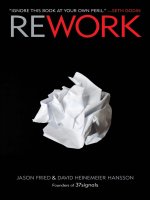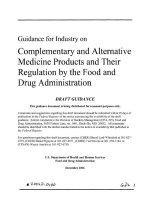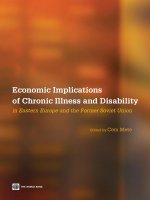Engineering economic 14th by william sullivan and koeling ch 06
Bạn đang xem bản rút gọn của tài liệu. Xem và tải ngay bản đầy đủ của tài liệu tại đây (211.13 KB, 30 trang )
Engineering Economy
Chapter 6: Comparison and Selection
Among Alternatives
Engineering Economy, Sixteenth Edition
By William G. Sullivan, Elin M. Wicks, and C. Patrick Koelling
Copyright ©2015 by Pearson Education, Inc.
Upper Saddle River, New Jersey 07458
All rights reserved.
The objective of chapter 6 is to
evaluate correctly capital
investment alternatives when the
time value of money is a key
influence.
Engineering Economy, Sixteenth Edition
By William G. Sullivan, Elin M. Wicks, and C. Patrick Koelling
Copyright ©2015 by Pearson Education, Inc.
Upper Saddle River, New Jersey 07458
All rights reserved.
Making decisions means
comparing alternatives.
• In this chapter we examine feasible design
alternatives.
• The decisions considered are those selecting
from among a set of mutually exclusive
alternatives—when selecting one excludes
the choice of any of the others.
Engineering Economy, Sixteenth Edition
By William G. Sullivan, Elin M. Wicks, and C. Patrick Koelling
Copyright ©2015 by Pearson Education, Inc.
Upper Saddle River, New Jersey 07458
All rights reserved.
Mutually exclusive alternatives
(MEAs)
• We examine these on the basis of economic
considerations alone.
• The alternatives may have different initial
investments and their annual revenues and costs
may vary.
• The alternatives must provide comparable
“usefulness”: performance, quality, etc.
• The basic methods from chapter 5 provide the
basis for economic comparison of the alternatives.
Engineering Economy, Sixteenth Edition
By William G. Sullivan, Elin M. Wicks, and C. Patrick Koelling
Copyright ©2015 by Pearson Education, Inc.
Upper Saddle River, New Jersey 07458
All rights reserved.
Apply this rule, based on
Principle 2 from Chapter 1.
The alternative that requires the minimum
investment of capital and produces
satisfactory functional results will be chosen
unless the incremental capital associated with
an alternative having a larger investment can
be justified with respect to its incremental
benefits. This alternative is the base
alternative.
Engineering Economy, Sixteenth Edition
By William G. Sullivan, Elin M. Wicks, and C. Patrick Koelling
Copyright ©2015 by Pearson Education, Inc.
Upper Saddle River, New Jersey 07458
All rights reserved.
For alternatives that have a larger
investment than the base…
If the extra benefits obtained by investing
additional capital are better than those that
could be obtained from investment of the
same capital elsewhere in the company at the
MARR, the investment should be made.
(Please note that there are some cautions when considering
more than two alternatives, which will be examined later.)
Engineering Economy, Sixteenth Edition
By William G. Sullivan, Elin M. Wicks, and C. Patrick Koelling
Copyright ©2015 by Pearson Education, Inc.
Upper Saddle River, New Jersey 07458
All rights reserved.
There are two basic types of
alternatives.
Investment Alternatives
Those with initial (or front-end) capital investment
that produces positive cash flows from increased
revenue, savings through reduced costs, or both.
Cost Alternatives
Those with all negative cash flows, except for a
possible positive cash flow from disposal of assets
at the end of the project’s useful life.
Engineering Economy, Sixteenth Edition
By William G. Sullivan, Elin M. Wicks, and C. Patrick Koelling
Copyright ©2015 by Pearson Education, Inc.
Upper Saddle River, New Jersey 07458
All rights reserved.
Select the alternative that gives
you the most money!
• For investment alternatives the PW of all
cash flows must be positive, at the MARR,
to be attractive. Select the alternative with
the largest PW.
• For cost alternatives the PW of all cash
flows will be negative. Select the alternative
with the largest (smallest in absolute value)
PW.
Engineering Economy, Sixteenth Edition
By William G. Sullivan, Elin M. Wicks, and C. Patrick Koelling
Copyright ©2015 by Pearson Education, Inc.
Upper Saddle River, New Jersey 07458
All rights reserved.
Investment alternative example
Use a MARR of 10% and useful life of 5 years to select
between the investment alternatives below.
Alternative
Capital investment
Annual revenues less expenses
A
B
-$100,000
-$125,000
$34,000
$41,000
Both alternatives are attractive, but Alternative B provides
a greater present worth, so is better economically.
Engineering Economy, Sixteenth Edition
By William G. Sullivan, Elin M. Wicks, and C. Patrick Koelling
Copyright ©2015 by Pearson Education, Inc.
Upper Saddle River, New Jersey 07458
All rights reserved.
Cost alternative example
Use a MARR of 12% and useful life of 4 years to select
between the cost alternatives below.
Alternative
C
D
Capital investment
-$80,000
-$60,000
Annual expenses
-$25,000
-$30,000
Alternative D costs less than Alternative C, it has a greater
PW, so is better economically.
Engineering Economy, Sixteenth Edition
By William G. Sullivan, Elin M. Wicks, and C. Patrick Koelling
Copyright ©2015 by Pearson Education, Inc.
Upper Saddle River, New Jersey 07458
All rights reserved.
Pause and solve
Your local foundry is adding a new furnace. There are
several different styles and types of furnaces, so the foundry
must select from among a set of mutually exclusive
alternatives. Initial capital investment and annual expenses
for each alternative are given in the table below. None have
any market value at the end of its useful life. Using a
MARR of 15%, which furnace should be chosen?
Furnace
F1
F2
F3
Investment
$110,000
$125,000
$138,000
Useful life
10 years
10 years
10 years
Total annual expenses
$53,800
$51,625
$45,033
Engineering Economy, Sixteenth Edition
By William G. Sullivan, Elin M. Wicks, and C. Patrick Koelling
Copyright ©2015 by Pearson Education, Inc.
Upper Saddle River, New Jersey 07458
All rights reserved.
Solution
Using a MARR of 15%, the PW is shown for each of the
three alternatives in the table below.
Furnace
F1
F2
F3
Investment
$110,000
$125,000
$138,000
Useful life
10 years
10 years
10 years
Total annual expenses
$53,800
$51,625
$45,033
Present Worth @ 15%
-$380,010
-$384,094
-$364,010
The largest value is -$364,010, indicating that Furnace
F3 is the best alternative.
Engineering Economy, Sixteenth Edition
By William G. Sullivan, Elin M. Wicks, and C. Patrick Koelling
Copyright ©2015 by Pearson Education, Inc.
Upper Saddle River, New Jersey 07458
All rights reserved.
Determining the study period.
• A study period (or planning horizon) is the time
period over which MEAs are compared, and it
must be appropriate for the decision situation.
• MEAs can have equal lives (in which case the
study period used is these equal lives), or they can
have unequal lives, and at least one does not match
the study period.
• The equal life case is straightforward, and was
used in the previous two examples.
Engineering Economy, Sixteenth Edition
By William G. Sullivan, Elin M. Wicks, and C. Patrick Koelling
Copyright ©2015 by Pearson Education, Inc.
Upper Saddle River, New Jersey 07458
All rights reserved.
Unequal lives are handled in one
of two ways.
• Repeatability assumption
– The study period is either indefinitely long or equal to a
common multiple of the lives of the MEAs.
– The economic consequences expected during the
MEAs’ life spans will also happen in succeeding life
spans (replacements).
• Coterminated assumption: uses a finite and
identical study period for all MEAs. Cash flow
adjustments may be made to satisfy alternative
performance needs over the study period.
Engineering Economy, Sixteenth Edition
By William G. Sullivan, Elin M. Wicks, and C. Patrick Koelling
Copyright ©2015 by Pearson Education, Inc.
Upper Saddle River, New Jersey 07458
All rights reserved.
Comparing MEAs with equal lives.
When lives are equal adjustments to cash flows are not
required. The MEAs can be compared by directly comparing
their equivalent worth (PW, FW, or AW) calculated using the
MARR. The decision will be the same regardless of the
equivalent worth method you use. For a MARR of 12%, select
from among the MEAs below.
Alternatives
A
B
C
D
-$150,000
-$85,000
-$75,000
-$120,000
Annual revenues
$28,000
$16,000
$15,000
$22,000
Annual expenses
-$1,000
-$550
-$500
-$700
Market Value (EOL)
$20,000
$10,000
$6,000
$11,000
10
10
10
10
Capital investment
Life (years)
Engineering Economy, Sixteenth Edition
By William G. Sullivan, Elin M. Wicks, and C. Patrick Koelling
Copyright ©2015 by Pearson Education, Inc.
Upper Saddle River, New Jersey 07458
All rights reserved.
Selecting the best alternative.
Present worth analysis select Alternative A (but C is
close).
Annual worth analysis—the decision is the same.
Engineering Economy, Sixteenth Edition
By William G. Sullivan, Elin M. Wicks, and C. Patrick Koelling
Copyright ©2015 by Pearson Education, Inc.
Upper Saddle River, New Jersey 07458
All rights reserved.
Using rates of return is another
way to compare alternatives.
• The return on investment (rate of return) is a popular
measure of investment performance.
• Selecting the alternative with the largest rate of return can
lead to incorrect decisions—do not compare the IRR of
one alternative to the IRR of another alternative. The only
legitimate comparison is the IRR to the MARR.
• Remember, the base alternative must be attractive (rate of
return greater than the MARR), and the additional
investment in other alternatives must itself make a
satisfactory rate of return on that increment.
Engineering Economy, Sixteenth Edition
By William G. Sullivan, Elin M. Wicks, and C. Patrick Koelling
Copyright ©2015 by Pearson Education, Inc.
Upper Saddle River, New Jersey 07458
All rights reserved.
Use the incremental investment
analysis procedure.
• Arrange (rank order) the feasible alternatives
based on increasing capital investment.
• Establish a base alternative.
– Cost alternatives—the first alternative is the base.
– Investment alternatives—the first acceptable
alternative (IRR>MARR) is the base.
• Iteratively evaluate differences (incremental cash
flows) between alternatives until all have been
considered.
Engineering Economy, Sixteenth Edition
By William G. Sullivan, Elin M. Wicks, and C. Patrick Koelling
Copyright ©2015 by Pearson Education, Inc.
Upper Saddle River, New Jersey 07458
All rights reserved.
Evaluating incremental cash flows
• Work up the order of ranked alternatives smallest to largest.
• Subtract cash flows of the lower ranked alternative from
the higher ranked.
• Determine if the incremental initial investment in the
higher ranked alternative is attractive (e.g., IRR>MARR,
PW, FW, AW all >0). If it is attractive, it is the “winner.”
If not, the lower ranked alternative is the “winner.” The
“loser” from this comparison is removed from
consideration. Continue until all alternatives have been
considered.
• This works for both cost and investment alternatives.
Engineering Economy, Sixteenth Edition
By William G. Sullivan, Elin M. Wicks, and C. Patrick Koelling
Copyright ©2015 by Pearson Education, Inc.
Upper Saddle River, New Jersey 07458
All rights reserved.
Incremental analysis
Initial cost
Net annual income
IRR on total cash flow
Alt. A
Alt. B
Alt. B-Alt. A
-$25,000
-$35,000
-$10,000
$7,500
$10,200
$3,200
15%
14%
11%
Which is preferred using a 5 year study period and MARR=10%?
Both alternatives A and B are acceptable—each one has a rate of return
that exceeds the MARR. Choosing Alternative A because of its larger
IRR would be an incorrect decision. By examining the incremental cash
flows we see that the extra amount invested in Alternative B earns a
return that exceeds the IRR—so B is preferred to A. Also note…
Engineering Economy, Sixteenth Edition
By William G. Sullivan, Elin M. Wicks, and C. Patrick Koelling
Copyright ©2015 by Pearson Education, Inc.
Upper Saddle River, New Jersey 07458
All rights reserved.
Pause and solve
Acme Molding is examining 5 alternatives for a piece of
material handling equipment. Each has an expected life of 8
years with no salvage value, and Acme’s MARR is 12%.
Using an incremental analysis, which material handling
alternative should be chosen? The table below includes
initial investment, net annual income, and IRR for each
alternative.
Alternative
A
B
Capital
investment
$12,000
$12,500
$14,400
$16,250
$20,000
Net annual
income
$2,500
$2,520
$3,050
$3,620
$4,400
IRR
12.99%
12.04%
13.48%
14.99%
14.61%
Engineering Economy, Sixteenth Edition
By William G. Sullivan, Elin M. Wicks, and C. Patrick Koelling
C
D
E
Copyright ©2015 by Pearson Education, Inc.
Upper Saddle River, New Jersey 07458
All rights reserved.
Solution
Alternative A is the base alternative, with an IRR > MARR.
The next largest investment is in Alternative B, so first
examine the incremental investment of B over A. In the
table below the IRR of B – A is shown.
Alternative
A
B
B-A
Capital
investment
$12,000
$12,500
$500
Net annual
income
$2,500
$2,520
$20
12.99%
12.04%
-20.11%
IRR
Alternative B is not better than A—A “wins.”
Engineering Economy, Sixteenth Edition
By William G. Sullivan, Elin M. Wicks, and C. Patrick Koelling
Copyright ©2015 by Pearson Education, Inc.
Upper Saddle River, New Jersey 07458
All rights reserved.
Solution
The next largest investment is in Alternative C, so examine
the incremental investment of C over A. In the table below
the IRR of C – A is shown.
Alternative
A
C
C-A
Capital
investment
$12,000
$14,400
$2,400
Net annual
income
$2,500
$3,050
$550
12.99%
13.48%
15.86%
IRR
15.86% > MARR, so Alternative C “wins.”
Engineering Economy, Sixteenth Edition
By William G. Sullivan, Elin M. Wicks, and C. Patrick Koelling
Copyright ©2015 by Pearson Education, Inc.
Upper Saddle River, New Jersey 07458
All rights reserved.
Solution
The next largest investment is in Alternative D, so examine
the incremental investment of D over C. In the table below
the IRR of D – C is shown.
Alternative
C
D
D-C
Capital
investment
$14,400
$16,250
$1,850
Net annual
income
$3,050
$3,620
$570
13.48%
14.99%
25.94%
IRR
25.94% > MARR, so Alternative D “wins.”
Engineering Economy, Sixteenth Edition
By William G. Sullivan, Elin M. Wicks, and C. Patrick Koelling
Copyright ©2015 by Pearson Education, Inc.
Upper Saddle River, New Jersey 07458
All rights reserved.
Solution
Finally, examine the incremental investment of E over D.
Alternative
D
E
E-D
Capital
investment
$16,250
$20,000
$3,750
Net annual
income
$3,620
$4,400
$780
14.99%
14.61%
12.95%
IRR
12.95% > MARR, so Alternative E “wins,” and we would
select Alternative E as the best of these five alternatives.
Engineering Economy, Sixteenth Edition
By William G. Sullivan, Elin M. Wicks, and C. Patrick Koelling
Copyright ©2015 by Pearson Education, Inc.
Upper Saddle River, New Jersey 07458
All rights reserved.









